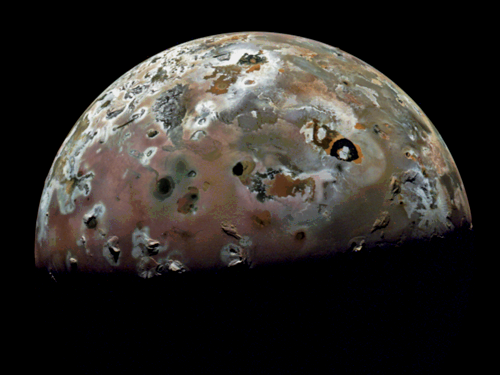
The Juno mission got extremely close to Io to learn more about its volcanic activity and plans to take more photos in February.
NASA’s Juno mission ended 2023 with a venture around Io, one of Jupiter’s moons and the most volcanic location in our solar system, according to the agency.
The Juno spacecraft conducted a flyby of Jupiter’s moon on 30 December – the closest pass that any spacecraft has made in more than 20 years.
Juno has previously monitored Io’s volcanic activity from distances ranging from about 11,000 km to 100,000 km, but the recent venture saw the spacecraft soar only 1,500 km above the volcanic surface.
The new images are being used to learn more about Io’s volcanic activity, such as the temperature of the volcanos, how often they erupt and how Io’s activity is connected to charged particles in Jupiter’s magnetosphere.
A second flyby is scheduled for 3 February, which will put Juno in a similar close range to Io to observe its volcanic activity. Dr Scott Bolton, the principal investigator of the Juno mission, spoke about the objectives of these flybys last month.
“With our pair of close flybys in December and February, Juno will investigate the source of Io’s massive volcanic activity, whether a magma ocean exists underneath its crust, and the importance of tidal forces from Jupiter, which are relentlessly squeezing this tortured moon,” Bolton said.
The latest flyby marked Juno’s 57th orbit around Jupiter, which has caused the spacecraft to endure punishing levels of radiation. Juno project manager Ed Hirst said last month that the radiation has begun to show on images of the spacecraft’s JunoCam in previous orbits.
“Pictures from the last flyby show a reduction in the imager’s dynamic range and the appearance of ‘striping’ noise,” Hirst said last month. “Our engineering team has been working on solutions to alleviate the radiation damage and to keep the imager going.”
In 2022, two close-up images of Jupiter’s outer atmosphere were created by citizen scientist Björn Jónsson using publicly available raw data from the JunoCam instrument aboard the spacecraft.
10 things you need to know direct to your inbox every weekday. Sign up for the Daily Brief, Silicon Republic’s digest of essential sci-tech news.

